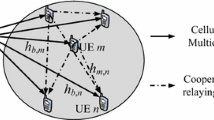Abstract
In this paper, the cellular system and broadcasting system use a cooperative transmission scheme. The conventional scheme is not consider the condition of a channel between a cellular base station (CBS) and a destination user. In this conventional scheme, two CBSs communicate with the user by the cooperative transmission scheme when the user is located in the cell edge. If CBS is distant from a user and the channel condition is poor, the performance of communication is degraded. The proposed scheme using the relay between CBS and the user located in the edge of CBSs improves the performance of the communication when the channel state between CBS and the user is bad. Also, space time block code and cyclic delay diversity scheme are used for the reliable transmission in the proposed scheme. The proposed scheme using the relay achieves good BER and throughput performance. Through the simulation, it is confirmed that the proposed scheme is better than the conventional scheme.





Similar content being viewed by others
References
Liu, R., & Elmirghani, J. (2010). Hybrid detectors for wireless orthogonal frequency division multiplexing with code division multiplexing systems based on reliability information. The Institution of Engineering and Technology, 4(2), 154–166.
Joshi, S., Bansl, K., Nagori, S. & Agrawal, H. (2008). Analysis of multiple input multiple output (MIMO) systems and adaptive arrays for wireless communication, In Proceedings of IEEE 8th International Conference, (pp.882–884).
Gowrishankar, R., Demirkol, M. F., & Yun, Z. (2005). Adaptive modulation for MIMO systems and throughput evaluation with realistic channel model. IEEE Wireless Networks, Communications and Mobile Computing International Conference, 2, 851–856.
Karkhanechi, H. M. & Levy, B. C. (2003). Spatial multiplexing and diversity gain in OFDM-based MIMO systems, In IEEE Topical Conference on Wireless Communication Technology, (pp.299–301).
Kwon, B.-N., Shin, H.-J., & Song, H.-K. (2014). An improved cooperative transmission scheme using an adjacent base station in vehicular communication system. IEEE Transactions on Fundamentals, E97–A(12), 2649–2652.
Han, S.-Y., Ahn, S. W., Oh, E.-S., & Hong, D.-S. (2009). Effect of channel estimation error on BER performance in cooperative transmission. IEEE Transactions on Vehicular Technology, 58(4), 2083–2088.
Paik, J.-I., Lee, E.-H., Jeong, H.-Y. & Song, H.-K. (2012). Link adaptive cooperative communication with smart relays for MIMO-OFDMA. Information Science and Industrial Applications 2012, 94–97.
Janevski, T., Janevska, M., Tudzarov, A., Stojanovski, P. & more authors. (2005). Interworking of cellular networks and hotspot wireless LANs via integrated accounting system, In Proceedings of the IEEE 1st International Conference, (pp.72–78).
Wei, D., Deng, L., Rui, Y., Li, M. & Wang, F. (2012). “Cooperative transmission with broadcasting and communication,” In Proceedings of the IEEE 4th International Conference, Intelligent Networking and Collaborative Systems (INCoS), Bucharest, Romania, (pp. 541–545).
Li, W., Chen, J., Long, H. & Wu, B. (2012). Performance and analysis on LTE system under adjacent channel interference of broadcasting system, In Proceedings of the IEEE 12th International Conference, (pp.290–294).
Tuttlebee, W., Babb, D., Irvine, J., Martinez, G., & Worrall, K. (2003). Broadcasting and mobile telecommunications: Interworking—not convergence. EBU Technical Review, 293, 1–11.
Taniguchi, T., Karasawa, Y. & Nakajima, N. (2010). Performance improvement of multiantenna cellular system using cooperation of base stations and relay stations, In IEEE Global Telecommunications Conference, (pp.1–6).
Huang, F., Zhen, L., Rui, Y., Dongdong, W. & Li, M. (2013). Coverage performance and comparison between broadcasting and cellular systems, In IEEE Wireless Communications and Networking Conference Workshops, (pp.35–38).
Yoon, J.-S., Lim, H.-M., Park, H.-J. & Song, H.-K. (2010). Performance evaluation of cooperative communication for OFDMA based wireless communication system, In IEEE Communication Technology, (PP.780–783).
Nagate, A., Ogata, D. & Fujii, T. (2012). “Cell edge throughput improvement by base station cooperative transmission control with reference signal interference canceller in LTE system,” In IEEE Softbank Mobile Corp..
You, X., Wang, D., Zhu, P., & Sheng, B. (2011). Cell edge performance of cellular mobile systems. IEEE Journal on Selected Areas in Communications, 29(6), 1139–1150.
Hosein, P. (2009). Adaptive algorithm for mapping channel quality information to modulation and coding schemes, In Proceedings of the IEEE 69th Vehicular Technology Conference, (pp.1–4).
Sklar, B. (2001). Digital communications: Fundamentals and applications. Upper Saddle River: Prentice Hall PTR.
Panaitopol, D., Kong, P. Y., Tham, C. K. & Fiorina, J. (2010) An efficient cooperative transmission scheme using multiple relays incrementally, In Proceedings of the IEEE 21st International Symposium, (pp.1122–1127).
Ju, M.-C., Hwang, K.-S., & Song, H.-K. (2013). Relay selection of cooperative diversity networks with interference-limited destination. IEEE Transactions on Vechicular Technology, 62(9), 4658–4665.
Tarokh, V., Jafarkhani, H., & Calderbank, A. R. (1999). Space-time block coding for wireless communications: Performance results. IEEE Journal of Selected Areas in Communications, 17(3), 451–460.
Bosserty, M., Huebnery, A., Schuehleiny, F., Hassz, H. & Costaz, E. (2002) “On cyclic delay diversity in OFDM based transmissionschemes,” In Proceedings of the 7th International OFDM-Workshop, (pp.1–5).
Klein, A., Kaleh, G. K., & Baier, P. W. (1996). Zero forcing and minimum mean-square-error equalization for multiuser detection in code-division multiple-access channels. IEEE Transactions on Vehicular Technology, 45(2), 276–287.
Acknowledgements
This research was supported by the IT R&D program of MOTIE/KEIT [10054819, Development of modular wearable platform technology for the disaster and industrial site] and Basic Science Research Program through the National Research Foundation of Korea(NRF) funded by the Ministry of Education(No. NRF-2016R1D1A1B03931160).
Author information
Authors and Affiliations
Corresponding author
Rights and permissions
About this article
Cite this article
Yang, HJ., Kwon, BN., Baik, JI. et al. Cooperative Transmission Scheme Using the Single Antenna in the Broadcasting and Cellular System. Wireless Pers Commun 95, 4049–4061 (2017). https://doi.org/10.1007/s11277-017-4039-0
Published:
Issue Date:
DOI: https://doi.org/10.1007/s11277-017-4039-0




